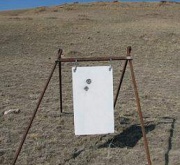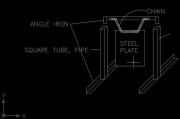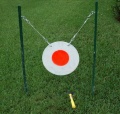Gong
Gongs are popular targets for casual shooting, particularly among youngsters, as their movement and the resonant sound they give off when hit provides shooters with a bit of the "instant gratification" of knowing they hit their target without having to wait until the round is over before checking a paper target. Gongs also have the added advantage of not having to be retrieved from the far end of the range after each round (this can be quite nice if you're shooting at 400 yards).
While many clubs have several gongs on their ranges, some clubs have chosen not to allow them at all, citing concerns over the possibility of ricochets off the metal materials.
Contents |
[edit] Construction
Gongs are not only fun to shoot, they're also rather easy to make with common materials and relatively little work. But like anything else, if it's worth doing, it's worth doing right. Proper materials and workmanship go a long way towards increasing your shooting enjoyment.This section lists some of the things that you should keep in mind if you decide to make your own.
[edit] Materials and general concerns
A few things to keep in mind as you design your gong and prepare to pick out materials:
- Make sure the steel is thick enough not to dent or pocket
Dents and pockets make for unpredictable angles of impact and increase the likelihood of a ricochet heading back towards the shooter. That is a Very Bad Thing™.
Usually, 1/2 in. (12mm) is sufficient thickness to withstand repeated impact from pistol rounds up to about the .30 caliber neighbourhood. The idea is to, as much as possible, completely flatten the projectile on impact. Thicker gongs will obviously last longer and angling the gong downward will further decrease the odds of problematic ricochets. - But don't make it too heavy
Half the fun of gongs is seeing them move when you hit them. Use lighter materials if you're going to be using lower powered rounds. - Choose proper materials
Even high carbon railroad steel will dent with a good rifle round; bear this in mind when designing your gong. Likewise, very hard materials, when shot with some more low-power rounds like .22 LR, can create some unpredictable bounces. Decide what kind of ammo you will be shooting it with, and pick materials appropriately. When in doubt, consult with a professional. - Let 'em swing
A gong should NOT be immovable; DO NOT put a gong on a rigid mount! The swing of the gong does more than make for a nice sight and absorb some of the energy of the bullet's impact; it also acts as a safety feature. An unmoving hunk of metal, struck by a high speed projectile, can quickly become an instructor in the geometric law that angle of impact equals angle of deflection, resulting in an increased likelihood of the bullet coming back at the shooter. As we have already established, that is a Very Bad Thing™. (Methods of suspension are discussed below) - Use strong chain
If your gongs are suspended from chains, make sure they are thick enough that a stray round is not going to be likely to sever them. And for cryin' out loud, DO NOT USE ROPE. Seriously. Unless you're the kind of person who likes having to trot downrange and fix your gongs a lot... - Size them appropriately
Chain impacts are much less likely to occur if the gongs are of a size that the shooter is more likely to hit. Remember that gong shooting isn't exactly an Olympic sport; relax and have some fun!
It's also worth mentioning that if your gongs are painted white or a another easily contrasted colour, seeing the point of impact at longer ranges (where you may not be able to hear the "ding" of the hit) becomes much easier.
[edit] Suspension
There are three main ways in which a gong can be suspended, which we will refer to as hinge, chain, and lever. We'll cover each of them, one at a time.
The hinge method
The hinge method involves attaching a metal tube, or similar device, to the rear of the gong, near the top. A supporting rod (or, less commonly, a chain) is then run through the tube to support the target off the ground. Because of the way objects behave when they are hanged, this method works best for rectangular or oval targets -- or any other shape, so long as it's taller than it is wide. Figure 1 shows a pair of rectangular gongs using the hinge method, supported by a "saw horse" stand.
Chains
A gong can also be suspended using chains, braided steel cable, or another similar material. The chains can then be attached to an overhead crosspiece or to flanking vertical supports. Note that rope is NOT recommended for this, since it is obviously more vulnerable to stray shots then metal materials will be. Figure 2 shows a round gong suspended between two stakes using light, wrapped steel cable. While this type of cable would likely not survive an impact from a large caliber round (even from a pistol cartridge), this sort of target will do just fine for some rimfire plinking.
An important consideration when suspending gongs by chains or cables is that they should be held up by at least two supports. Figure 3 shows a round gong with a single chain support. While the designer of this gong did think to include two additional securing lines, it is very easy to see how the surface of a gong dangling from a single line can easily change its angle to the shooter along the yaw axis, making the direction of the rebounding bullet much more unpredictable.
50 ways to love your lever
The lever configuration is arguably the best way to suspend a gong. A rigid arm is suspended from a horizontal bar, which it is attached to by means of a single-axis hinge-type method. The gong is firmly secured to the bottom of this swinging arm.
The lack of bottom restraint means that the arm, along with the gong attached, will swing back when struck by a round, and the solid mounting of the gong to the rigid arm means that -- unlike the other designs -- the designer has absolute control over the pitch of the gong surface in relation to the perpendicular. Placing the supports on an uphill or downhill slope will have no effect on the angle of the target vis-a-vis the horizon, as the supporting arm of the target will always be pulled down to the same angle by gravity. *[1]*
The downside of the lever configuration is that it's also most expensive, in terms of materials, and the most work to put together. Figure 4 shows a series of seven targets, with the five rightmost suspended by the lever method.
[edit] Safety concerns
Like any other aspect of shooting sports, there are safety concerns which must be addressed when shooting gongs. Some of these are listed below[2]:
- Keep distance in mind
Most, but by no means all, ricochets off a properly constructed gong will occur at an angle of approximately 45 degrees. Keep this in mind when deciding on the distance at which to set up gongs. Ten meters is usually the minimum safe distance. - Angle them down
Having your gongs tilted, top towards you and bottom away from you, will greatly increase the odds of rounds being deflected into the ground where they can't hurt anyone (except gophers, and they likely deserve it). - Choose the right ammo
Hollow points and wadcutters work best; jacketed/rifle rounds will increase the incidence of denting and pocketing on the gong (see above for more on that). Using lead and avoiding things like steel core ammo will prolong the life of your gong as well.
[edit] NOTES
- ↑ IMPORTANT SAFETY TIP: Just because the angle of the target does not change in relation to the horizon, that DOES NOT mean that it doesn't change in relation to YOU. Remembering your high school geometry can save you a lot of trouble in a situation like this.
- ↑ IMPORTANT SAFETY TIP: Don't think that these are the only things you need to think about. No list is ever a substitute for your own brains and common sense.





